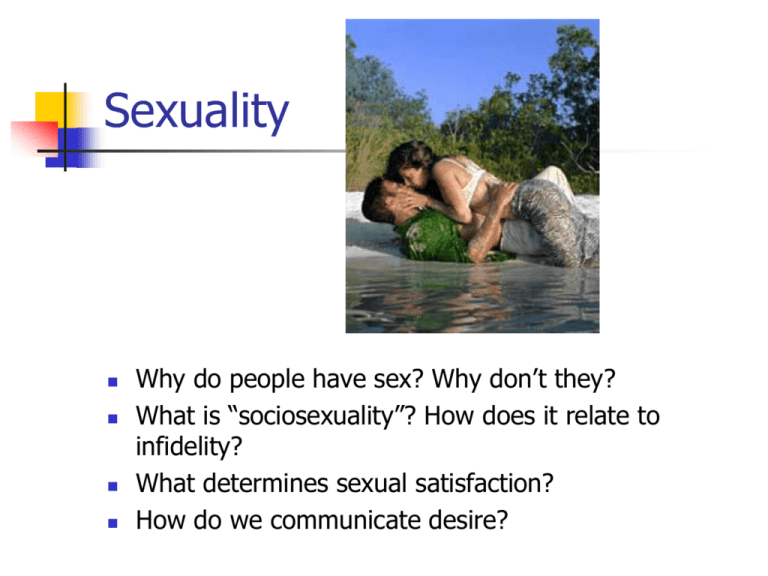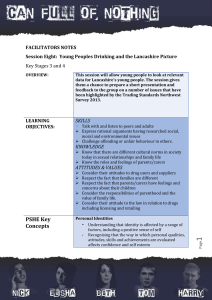
Sexuality
Why do people have sex? Why don’t they?
What is “sociosexuality”? How does it relate to
infidelity?
What determines sexual satisfaction?
How do we communicate desire?
Sexual Attitudes
1972 – 46% of respondents said sex between
a man and a woman before marriage was
“always or almost always wrong” (National
Opinion Research Center, 1972)
1996 – 32% said that it was “always or
almost always wrong”
But that is not to say most people endorse sex with
strangers
People generally disapprove of intercourse between
people in uncommitted relationships (Sprecher, McKinney, &
Orbuch, 1987)
People who are sexually active are viewed more
positively when described as being in a “serious”
rather than a “casual” relationship (Bettor, Hendrick, & Hendrick,
1995)
Most people also prefer their dating or
marriage partners to have had limited sexual
experience (McKinney & Maxwell, 1997)
Thus, today there seems to be a prerequisite
of relational attachment and affection for the
most appropriate context of sexual activity
But are there gender differences?
Gender Differences
On average, men tend to be more permissive
in their sexual attitudes than women
But this also depends on the attitude measured
One of the largest differences is on casual
premarital sex
Men are more likely to enjoy sex w/o intimacy
This difference has decreased over time (but what
has changed?)
Most Americans strongly disapprove of
extramarital affairs
Men have somewhat more permissive attitudes
towards them (Oliver & Hyde, 1993)
Cultural sexual attitudes
Sexual double standards
“Studs” and “sluts”
What does the research say?
Women who were described as sexually
active were not evaluated more negatively
than women who not described as sexually
active (Gentry, 1998)
In this study, sexually active women were
seen as more liberal and assertive
Men prefer potential spouses to be less
sexually permissive
But they favor permissive dating partners
Women prefer both potential dating partners
and spouses to be less permissive (Oliver &
Sedikides, 1992)
Attitudes about homosexuality
1973 – 81% of Americans believed that
homosexual sex was “always or almost
always wrong”
1996 – 62% thought it was “always or
almost always wrong” (NORC)
Attitudes about homosexuality extend past
the act of sex itself
More than half of Americans object to the
“homosexual lifestyle” (Turque, 1992)
Gay and lesbian relationships are assumed by
many to be dysfunctional and unhappy
Not supported by research (Peplau, Veniegas, &
Campbell, 1996)
Attitudes may continue to become more positive
More high-visibility gays and lesbians
Will & Grace, Ellen DeGeneres, Sheryl Swoopes
Civil unions in California
Personal contact with a gay or lesbian person may
promote positive attitudes towards homosexuals
(Herek & Glunt, 1993) (reciprocal influence)
Sexual behavior
First time for sex?
Approx. 16 for males and 17 for females
African-American males (14) earlier than whites or
Latinos
The general trend had been toward earlier
experiences
But rates of adolescent virginity have increased
Adolescent reasons for and
against having sex
Reasons for:
Express love and affection for partner
Curiosity
Peer pressure/want to please partner
Reasons against:
Potential for pregnancy, AIDS, STDs
Moral beliefs
Have not experiences sufficient love with partner
Feelings of insecurity or inadequacy (men)
Predictors of first-time sex
Premarital sex is associated with:
Confidence about being popular and attractive to
the opposite sex
A positive and accepting view of oneself
More experiences involving stressful physical or
family related events
Girls without a father present; boys whose families
change from intact to being without a father
Desire to achieve “adult status”
Teenagers who place greater emphasis on independence
Sex in committed relationships
Frequency
Couples co-habiting: 3 times/week
Married couples: 2 times/week
(Call, Sprecher, & Schwartz, 1995)
Both have sex more frequently than single people
Older people have sex less frequently
Decreased hormone levels
Interest may decrease (“sexual habituation”)
Sexual orientation
Initially gay men have more sex than lesbian or heterosexual
couples
After 10 years heterosexual couples have more sex
than gay couples
Lesbians have sex less frequently than the other
couples regardless of relationship duration
Infidelity
Recall Americans’ attitudes toward
extramarital sex
25% of married men and 15% of married
women report extramarital sex at least once
(Laumann et al., 1994)
Predictors?
Gender
Men are more likely to have an affair and are
more accepting of nonmonogamy in general
Gay men are most likely to report an instance of
extradyadic sex
Sociosexuality
A general orientation toward sex as either requiring
commitment or not
Computer dating video experiment (Seal et al., 1995)
Equity theory
Underbenefitted people report more affairs (Walster,
Traupmann, & Walster, 1978)
Replicated for wives by Prins, Buunk, and VanYperen (1993)
Sexual satisfaction
Almost 90% of respondents said they were “very” or
“extremely” physically satisfied with their sexual
relationships (National Health and Social Life Survey,
1994)
Numbers were somewhat higher for married couples
Other studies have found married couples to be quite
satisfied with their sex lives (e.g. Lawrence & Byers,
1995; Oggins, Loeber, & Veroff, 1993)
Sexual satisfaction is closely tied to sexual frequency
(Blumstein & Schwartz, 1983)
89% of married couples having sex 3 times/week or more
reported sexual satisfaction
Only 32% of spouses having sex once a month or less felt
the same satisfaction
Sexual satisfaction is associated with relationship
satisfaction
May be the correspondence between desired and actual
frequency
May be more sex than arguments (remember Gottman)
Exchange theories
Rewards
The degree of comfort with your partner
How you feel about yourself during or after sex
Physical sensations
Costs
Having sex when you or your partner is not in the mood
Lack of spontaneity
Infrequency
More rewards than costs, and having expectations
met lead to greater sexual satisfaction (Lawrence &
Byers, 1995)
Partners in equitable relationships report going
further sexually
Participants in equitable relationships reported more
sexual satisfaction (Traupmann, Hatfield, & Wexler,
1983)
Sexual communication
Verbally
Nonverbally
Kissing, touching, dressing attractively
Other indirect strategies?
Men are more likely to initiate sexual activity
The most common strategy for acceptance is
simply not resisting (Hickman & Muehlenhard,
1999)
People often have difficulty expressing
specific sexual desires
More likely to talk about likes than dislikes
Sexual self-disclosure is highest when partner
reciprocates
Clear communication about likes and dislikes
is associated with greater sexual satisfaction
Greater subjective quality of experience
Sexual miscommunication
Sexual aggression
May be that if a man perceives a woman as sexy
he hears “yes” even when she says no
Aggressive men may selectively ignore resistance
and use miscommunication as an excuse for rape
(Warshaw, 1994)
Kinsey Questions
Do you think that Kinsey made a contribution
to the field of human sexuality?
Do you agree or disagree with his methods?
Why?
Can you think of some alternative ways to
study human sexuality?







